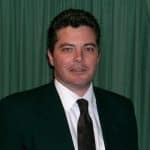Split apps of pre-emergent herbicides.
- First, less chance of turf injury; as you apply at lower rates you are less likely to damage turf;
- Second, split applications work really well on freely draining rootzones i.e. sand; they reduce the chance of waste from leaching and
- Third, using pre-emergents this way gives longer weed control later into the season especially if you use them with a post-emergent sulfonylurea herbicide application at the same time..
Things to think about when using split applications.
The timing of the second application is the main thing to think about. If you make the second application earlier in the season it gives better weed control.
If you wait too long to do it, it is counterproductive as the longer you leave this the more chance there is of weeds establishing. So the aim is to make the second treatment while the first is still working.
Remember that to work properly, these chemicals need weed seeds to germinate in the soil. So the water volume you use is important to wash the chemical off the turf surface and into the soil. Most pre-emergents are rapidly absorbed into the cuticle. So if you don’t apply the correct water volume they give poor weed control.
Soil moisture also affects the length of weed control. Moisture moves the chemical through the upper soil layer to create a protective layer. It is also needed for weeds to germinate. Therefore too get the best results you need to make sure that there is good soil moisture before and after you use a pre-emergent herbicide.
Granular pre-emergents are also worth looking at due to their ease of use. Options like the granular formulation Onset 10GR that contains the same active ingredient as Barricade herbicide are worth considering. Bear in mind, these can be vulnerable to heavy downpours that will wash away product, so water these in as soon as you can.
Pre-emergent herbicide half life dependent upon soil moisture content | |||
Active Ingredient | Trade Name | Approximate half-life in moist soil | Approximate half-life in saturated soil |
Indaziflam | Specticle | 120 days | 120 days |
Pennmag | 39 days | 24 days | |
Oryzalin | Prolan | 45 days | 5 days |
Oxadiazon | Ronstar | 60 days | 30-60 days |
Pendimethalin | Stomp | 45 days | 12 days |
Prodiamine | Barricade | 56 days | 28 days |
Trials using split apps of pre-emergent herbicides.
- In a trial using Freehand® and Specticle®, split applications of a half rate followed by a half rate three weeks later, gives longer weed control than the full rate.
- You get season-long summergrass control with split applications of prodiamine, pendimethalin, and dithiopyr, and it doesn’t matter which you use for the first and/or second application. The aim is to apply the same amount of active ingredient, as because split applications are more effective they give more consistent summergrass control than single applications.
- Research at CAFS into the effects of mowing height on single and split applications of preemergence herbicides for summergrass control.
- When mowed at 14mm, split applications give better control than single applications;
- When the height of cut is increased to 50mm, there are differences between single and split applications.
- When you mix Dispatch® with pre-emergents, it gives better summergrass control than only using pre-emergents. Recent trial work with abamectin plus Hydroforce® Ultra also gives better results and shows that soil wetting agents work as carriers for some turf chemicals.
- If you water in pre emergence herbicides straight after applying with 2.5 to 5mm of water, it gives up to a 50% increase in summergrass control in fairway-height Kentucky bluegrass.
- Pre-emergent herbicides don’t affect divot recovery.


Jerry Spencer
Graduated from Newcastle University with an Hons Degree in Soil Science in 1988, Jerry then worked for the Sports Turf Research Institute (STRI) as a turf agronomist before emigrating to Australia in 1993.
He followed this by gaining a Grad Dip in Business Management from UTS. He has worked in a number of management roles for companies as diverse as Samsung Australia, Arthur Yates and Paton Fertilizers.
He has always had a strong affinity with the Australian sports turf industry and as a result he established Gilba Solutions as an independent sports turf consultancy in 1993. Jerry has written over 100 articles and two books on a wide range of topics such as Turf Pesticides and Nutrition which have been published in Australia and overseas.

